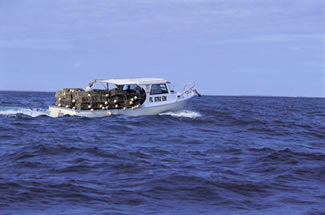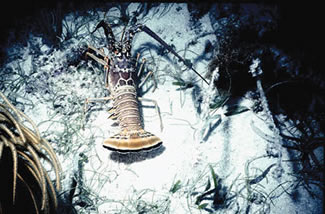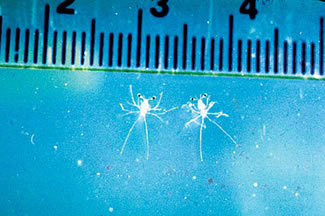May 16, 2011
By Joe Richard, Assistant Editor
Here's a fishery ripe for reform.
By Joe Richard, Assistant Editor

Lobster trap boat hauling gear. Florida trap numbers have dropped to half a million, but biologists say that number should be half. |
Despite an apparent uptick in South Florida spiny lobster landings last year, some researchers remain uneasy about the future of this fishery. Cracks are appearing in the picture, and changes may be in the wind. Any major declines in the resource will certainly have dramatic impacts on Florida's economy and marine ecology.
The lobster fishery generates millions of dollars in recreational and commercial landings each year, expenditures that support marinas, dive shops, hotels, boat dealers and more. In hard numbers, the Florida Fish and Wildlife Research Institute (FWRI) estimated back in 2001 that recreational lobster divers spent $24 million just in the Keys. The commercial value of lobsters caught in 1997 was $30 million. Those numbers fluctuate each year, and the 2001 season was admittedly a new low, but this is certainly a fishery worth protecting.
Martin Moe Jr., a retired marine biologist who literally wrote the book on spiny lobster, is stark in his assessment: “The fishery has been regulated to enhance short-term economic return to the fishery, over the long term health of the resource. But the resource is changing rapidly throughout its extensive range.” Moe serves on the Florida Keys National Marine Sanctuary Advisory Board. In discussing the status of the lobster resource, he identifies a number of documented and potential threats.
Net samples from the Gulf Stream tell us that Florida has received a steady supply of tiny young lobsters from the Caribbean for millennia. The larvae are spread north from the Caribbean, depending a great deal on the Gulf Stream current. Blessed with this steady conveyor belt of new lobster, it's a bounty easily taken for granted. Each year, trappers and divers in Florida have taken the vast majority of all legal lobsters available, confident that a new supply would always provide more.
Meanwhile, far to the south, developing countries have been diving headlong into increased lobster harvests of their own. In Honduras, for instance, word in the villages last summer was that the fishery is wiped out to depths as great as 100 feet. Villagers were making up to five deep dives each day, with a sizeable percentage of them winding up disabled or dead because of problems with nitrogren buildup. Last summer, Honduras was poised to close its harvest for two years to rebuild the fishery. But poaching likely continues and enforcement is difficult. With valuable U.S. dollars waiting for every lobster, Third World divers are willing to risk jail time, paralysis or worse.
Another bad problem affecting Florida stocks, Moe says, is the practice of using “short” lobsters as live bait in Florida's commercial traps. It's a trick to attract legal-size lobsters, which are highly communal and have to seek shelter during daylight hours. It has been estimated that up to 2.5 million undersize lobsters in Florida are killed every year through this practice, lost to the future. The practice is illegal in other lobster harvesting regions such as New England and Australia. The commercial use of shorts, which are strictly off limits to recreational divers, allows market trappers to avoid using escape hatches in Florida. In other waters escape hatches are required in order to let sub-legal lobsters leave the confines of the traps.
The Florida lobster industry maintains, as expected, that the commercial use of shorts with no escape holes is necessary to provide the most cost-effective taking of marketable lobsters.
Trap loss contributes to further declines in the fishery. Of the half million Florida commercial traps, 20 percent are lost annually. They're lost through storms, poachers moving them, boat propellers, or simply cut off and abandoned at season's end. That's when they become ghost traps, harvesting more lobsters and fish until they finally disintegrate. How many were lost during Florida's record hurricane season this past year remains to be seen. Most traps were likely in the water for the Aug. 6 commercial opening, a week before Hurricane Charley arrived, rampaging between Key West and the Dry Tortugas in prime lobster country. The other three Florida hurricanes didn't hit the Keys directly, but likely caused some choppy seas in lobster country.
“Hurricane Charley destroyed a number of traps west of Key West, though the actual numbers aren't known. They say it wasn't as bad as some previous storms,” said Doug Gregory, with Sea Grant in Key West.

Adult lobster leaves cover when "tickled." |
From that statement, 50,000 traps could have been lost to Charley, if a previous hurricane was more destructive.
Also a detriment from a marine biologist's viewpoint, is the minimum harvest size allowed for commercial and recreational harvesters. With only a 3-inch carapace required, Florida's lobsters have long been harvested before they ever reach spawning size. One of the normal requirements for sound management of a marine species is that they be allowed to spawn at least once.
Amidst growing human-related threats, nature is inflicting her own damage on lobster stocks. A virus has been discovered that is 100 percent lethal to lobsters, and it's been spreading, according to Moe. Young lobsters catch the disease most frequently, and Florida Bay's grassy nursery, prime habitat for young lobsters, is the most severely affected area. Since it's close to South Florida reefs, that may be a contributing factor to lower harvest in three of the last four years.
There are legislative systems in place to address many of these troubling harvest factors, but the wheels of management turn slowly. One promising item this year will likely be DNA studies that could determine which Caribbean countries are sending lobster larvae to Florida reefs with prevailing currents. “DNA techniques have advanced since the early 1990s,” says John Hunt, involved with state lobster research as director of the Florida Fish and Wildlife Conservation Commission marine lab in Marathon. “Back then we couldn't distinguish lobsters from one country or another. Now, we're hoping we'll get a bigger sense of where Florida lobsters originate.
Divers Getting Shorted? |
Commercial trappers take a lion's share of the lobster catch, largely due to powerful political lobbying over generations.
Lobsters are hauled off to market by the ton, many to foreign countries, despite the fact that recreational diving has been shown to provide a much better “economic rent” to society, according to many observers. The so-called rent represents the amount of expenditures paid to bring an animal to dockside.
There is also the question of simple fairness. Non-commercial diving under strict limits provides a far greater number of lobsters for a larger number of citizens.
As it is, trappers take four-fifths or more of the overall catch, though they're outnumbered by recreationals by hundreds to one. Many say the time is long past due for state authorities to take a fresh look at allocation policies and come up with more equity for the typical Floridian.
|
|
“Another study we're planning is to take all collected lobster data and pool it together. Maybe we can finally answer why some harvest years were poor. We have 11 years of data, of larvae arriving from deep water. We can compare that against juvenile lobster numbers inshore. We call it a meta-analysis.”
Another item open for debate this year could be trap re-design. Moe has spent some time researching and promoting “den traps” instead of the old-fashoned wooden traps. Dens are basically open-ended boxes, designed to be retrieved at times when lobsters are naturally inclined to hole up and stay put in daylight hours. He lists five good reasons for changing trap design:
>Den traps improve and enhance accessibility, which would eliminate the industry's perceived need for short lobsters as bait. That alone would save up to 20 percent of juvenile lobsters each year.
>The problems associated with ghost traps would also eventually be eliminated, since lost den traps would only function as habitat.
>Poaching traps at night is an old problem, but since lobsters would leave den traps to forage in darkness, commercial trappers would gain some protection from night-time poaching.
>As for the virus, it has been shown that healthy lobsters avoid contact with infected juveniles. With a den trap, they can leave—and infected juveniles would not be transported around to new areas, spreading the virus.
>And, when traps can't be harvested because of inclement weather, the lobsters inside den traps wouldn't starve or deteriorate as they have in older trap designs; they could forage and return.
As mentioned, annual landings have been fluctuating, which is setting off alarm bells. Last year's landing numbers are still trickling in.
“Commercial trap catches at the beginning of this last season were the highest in four years,” says Doug Gregory from Sea Grant. “There was a feeling of optimism. Our harvest here in the Florida Keys seems to coincide with Caribbean catches, which is mystifying.”
“Incoming catch data lags, because information arrives each month,” says Rick Beaver, a biologist with Florida's Fish and Wildlife Research Institute in St. Petersburg. “What has been reported since August 6 when the commercial season began is that 1.5 million pounds were landed. We're still considering data from the previous season, as it trickles in.”
Recreational participation has been creeping downward. Bill Sharp, with the Marine Division of Florida Fish and Wildlife Conservation Commission, says the past five years saw sales of the two-dollar, special license slowly dropping, with 123,000 stamps sold during the 2002-2003 season. The 1999-2000 season saw the highest stamp sales, at 140,000. As for the mini-season, participation has been stable with 50,000 participants on average, from 1993-2003.

Tiny phylosome stage of lobster. |
Recreational participation also fluctuates for various reasons, including lower catches. But many divers will always head for the Keys, as long as lobster season opens. And it sounds like the bugs are still there.
Brian Kiel from Gainesville was a new diver to the Keys last summer. He had no honeyhole ledges to seek out with the GPS, but he was still satisfied with the bug hunting there. “We did the mini-season in Key Largo, and then Key West for the regular opener. It was our first time in Key West, and the visibility was initially bad, though it cleared after two days. There were six of us, mostly towing a diver on the Gulf side to find ledges, snorkeling down to 15 feet. We got 90 bugs there, though a few were grabbed on the Atlantic side with scuba gear in deeper water. During the two-day mini-season we got 67 bugs off Key Largo, and that was great too. We had to work for them, and didn't always limit out.
Numbers may be satisfactory in some areas, but the overall picture is still troubling.
As Martin Moe says, “The fate of Florida stocks depends on two important things: How well we manage the spiny lobster resource on our own reefs, and how well stocks are managed throughout the western tropical Atlantic (Caribbean). If they're fished to the nub wherever they occur, as Florida stocks are, then a collapse at some future time of the entire Caribbean lobster resource is inevitable.”
FS
